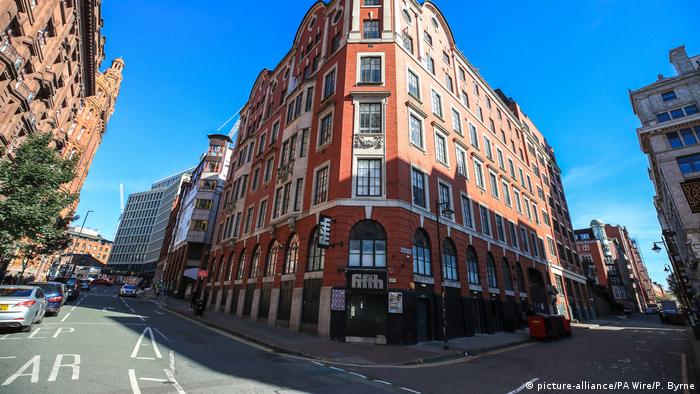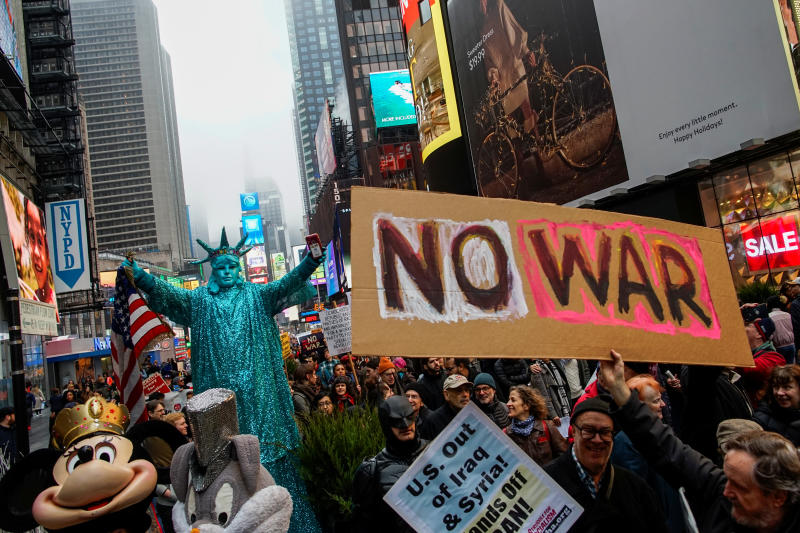A year of protest, as seen through street art
From Argentina to Lebanon, images that defined a year of unrest.
By Hannah Brown hannah.brown@voxmedia.com Dec 31, 2019
2019 will go down as a year of worldwide unrest. In the last few months, protests have raged from Haiti and Venezuela to Iraq and Lebanon, from Russia to Canada.
Around the world, citizens are frustrated about inaction on climate change or angry about government corruption. Some protests have made international news; others have come and gone with less attention. But one thing many of them have in common is the presence of protest art.
The quality and wit of signs, murals, and costumes are striking, prompting viewers around the world to think about the movements in new ways.
The appeal of a nonverbal, approachable commentary in the world of social media is not lost on activists. In Lebanon, anti-government protestors portrayed politicians as the Joker. In Santiago, Chile, women unfurled a banner to protest gender-based violence.
Here’s a look at some of the works from around the world.
South and Latin America
Argentina
:no_upscale()/cdn.vox-cdn.com/uploads/chorus_asset/file/19433664/GettyImages_1184038609.jpg)
Members of leftist parties and Bolivian citizens watch a burning dummy depicting President Trump during a demonstration in support of Bolivia’s overthrown president Evo Morales in front of the US embassy in Buenos Aires, on November 22, 2019. Juan Mabromata/AFP/Getty Images
Chile
:no_upscale()/cdn.vox-cdn.com/uploads/chorus_asset/file/19433808/GettyImages_1185528064.jpg)
Women protest against gender violence and the government in Santiago, Chile, on November 29, 2019. Javier Torres/AFP/Getty Images
Colombia
:no_upscale()/cdn.vox-cdn.com/uploads/chorus_asset/file/19433833/GettyImages_1185618524.jpg)
Colombian indigenous people and students protest on the eighth consecutive day against the government of Colombian President Ivan Duque in Bogota on November 29, 2019. S Juan Carlos Torres/NurPhoto via Getty Images
Venezuela
:no_upscale()/cdn.vox-cdn.com/uploads/chorus_asset/file/19433838/GettyImages_1124573397.jpg)
A mother and daughter walk by anti-Nicolas Maduro graffiti, who is rendered as “Salt Bae” in Caracas, Venezuela, on February 12, 2019. Roman Camacho/SOPA Images/LightRocket via Getty Images
Middle East
Iran
:no_upscale()/cdn.vox-cdn.com/uploads/chorus_asset/file/19433870/GettyImages_1179425670.jpg)
An Iranian man walks past a mural painted on the walls of the former US embassy in Tehran on November 2, 2019. Atta Kenare/AFP/Getty Images
Iraq
:no_upscale()/cdn.vox-cdn.com/uploads/chorus_asset/file/19433887/GettyImages_1186560628.jpg)
An Iraqi protester paints on a concrete barrier on al-Rasheed street in the capital Baghdad, during a lull in the anti-government demonstrations on December 5, 2019. Ahmad Al Rubaye/AFP/Getty Images
Lebanon
:no_upscale()/cdn.vox-cdn.com/uploads/chorus_asset/file/19433850/GettyImages_1181885414.jpg)
Anti-government protesters sit under graffiti depicting Lebanese politicians as Joker in downtown Beirut on November 12, 2019. Joseph Eid/AFP/Getty Images
Palestine
:no_upscale()/cdn.vox-cdn.com/uploads/chorus_asset/file/19433904/GettyImages_1151656328.jpg)
A Palestinian woman in Gaza City walks past a wall with graffiti showing President Trump with a footprint on his face on June 23, 2019. The Arabic text below reads, in Arabic: “For al-Quds (Jerusalem) and the right of return we resist.” Majdi Fathi/NurPhoto via Getty Images
Sudan
:no_upscale()/cdn.vox-cdn.com/uploads/chorus_asset/file/19433915/GettyImages_1139270274.jpg)
Sudanese protesters sit in front of a recently painted mural during a demonstration near the army headquarters in the capital Khartoum on April 24, 2019. With the fall of veteran leader Omar al-Bashir, Sudan’s long-stifled graffiti artists have been able to express their art. Ozan Kose/AFP/Getty Images
Europe and Asia
Hong Kong
:no_upscale()/cdn.vox-cdn.com/uploads/chorus_asset/file/19433957/GettyImages_1172552242.jpg)
Lok Yi, a 27-year-old art student, folds paper cranes in the Times Square shopping area of Causeway Bay in Hong Kong, on September 29, 2019, as part of ongoing anti-government protests. Marcus Yam / Los Angeles Times via Getty Images
Russia
:no_upscale()/cdn.vox-cdn.com/uploads/chorus_asset/file/19433949/GettyImages_1169606116.jpg)
A protester holds a banner demanding the release of actor Pavel Ustinov in Moscow, Russia, on September 19, 2019. Ustinov was sentenced to three-and-a-half years in jail for participating in anti-government protests. Celestino Arce/NurPhoto via Getty Images
Ukraine
:no_upscale()/cdn.vox-cdn.com/uploads/chorus_asset/file/19434022/GettyImages_1096679618.jpg)
Activists hold a banner depicting Ukrainian anti-corruption campaigner Kateryna Gandzyuk in Kiev, Ukraine, on February 9, 2019. Gandzyuk died from injuries from an acid attack in July 2018. STR/NurPhoto via Getty Images
North America
Canada
:no_upscale()/cdn.vox-cdn.com/uploads/chorus_asset/file/19434056/GettyImages_1176663034.jpg)
High school students lie on the ground as they protest climate change in front of the Canadian prime minister’s campaign office in Montreal on October 18, 2019. Louis Baudoin/AFP/Getty Images OTTAWA IS THE CAPITOL OF CANADA
United States
Parents and their children held a rally outside Governor Andrew Cuomo’s offices in Manhattan on December 5, 2019, protesting against the controversial bills being proposed that would allow children to be vaccinated with STD vaccines without parental knowledge or consent. Erik McGre
 Enlarge
Enlarge






/cdn.vox-cdn.com/uploads/chorus_image/image/66001017/92430295.jpg.0.jpg)

:no_upscale()/cdn.vox-cdn.com/uploads/chorus_asset/file/19433664/GettyImages_1184038609.jpg)
:no_upscale()/cdn.vox-cdn.com/uploads/chorus_asset/file/19433808/GettyImages_1185528064.jpg)
:no_upscale()/cdn.vox-cdn.com/uploads/chorus_asset/file/19433833/GettyImages_1185618524.jpg)
:no_upscale()/cdn.vox-cdn.com/uploads/chorus_asset/file/19433838/GettyImages_1124573397.jpg)
:no_upscale()/cdn.vox-cdn.com/uploads/chorus_asset/file/19433870/GettyImages_1179425670.jpg)
:no_upscale()/cdn.vox-cdn.com/uploads/chorus_asset/file/19433887/GettyImages_1186560628.jpg)
:no_upscale()/cdn.vox-cdn.com/uploads/chorus_asset/file/19433850/GettyImages_1181885414.jpg)
:no_upscale()/cdn.vox-cdn.com/uploads/chorus_asset/file/19433904/GettyImages_1151656328.jpg)
:no_upscale()/cdn.vox-cdn.com/uploads/chorus_asset/file/19433915/GettyImages_1139270274.jpg)
:no_upscale()/cdn.vox-cdn.com/uploads/chorus_asset/file/19433957/GettyImages_1172552242.jpg)
:no_upscale()/cdn.vox-cdn.com/uploads/chorus_asset/file/19433949/GettyImages_1169606116.jpg)
:no_upscale()/cdn.vox-cdn.com/uploads/chorus_asset/file/19434022/GettyImages_1096679618.jpg)
:no_upscale()/cdn.vox-cdn.com/uploads/chorus_asset/file/19434056/GettyImages_1176663034.jpg)
:no_upscale()/cdn.vox-cdn.com/uploads/chorus_asset/file/19436638/1186718998.jpg.jpg)
/cdn.vox-cdn.com/uploads/chorus_image/image/66018011/GettyImages_1146803362.0.jpg) Activists in Berlin stood with signs calling for limiting global warming to 1.5 degrees Celsius at a rally that criticized Germany’s insufficient climate policy on May 29, 2019. Michael Kappeler/picture alliance via Getty Image
Activists in Berlin stood with signs calling for limiting global warming to 1.5 degrees Celsius at a rally that criticized Germany’s insufficient climate policy on May 29, 2019. Michael Kappeler/picture alliance via Getty Image:no_upscale()/cdn.vox-cdn.com/uploads/chorus_asset/file/19205807/GettyImages_1167860285.jpg) Swedish climate activist Greta Thunberg and others at a rally. Sarah Silbiger/Getty Images
Swedish climate activist Greta Thunberg and others at a rally. Sarah Silbiger/Getty Images:no_upscale()/cdn.vox-cdn.com/uploads/chorus_asset/file/7195057/oci-scenarios-2-1_5.png)